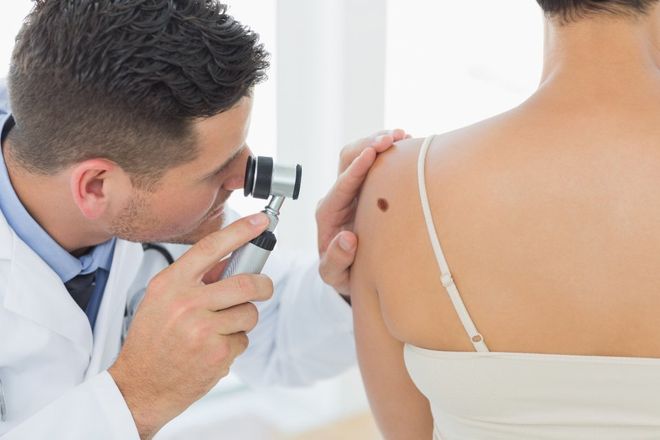When To Check On Moles
Last Updated on June 3, 2023
If you have moles, it’s important to keep an eye on them for signs of skin cancer. Here’s how to determine if your skin mole is cause for concern.
Everyone has moles on their skin. On average, most people have at least 10, but less than 40 moles. A mole can appear anywhere on your body, and most moles appear by age 20.
Although your pattern of moles is most likely determined by your genetics, sun exposure can cause you to have more moles, and can cause the ones you already have to get darker. New moles tend to appear and existing ones tend to get larger and darker during your teen years and if you become pregnant.
Types of Skin Moles
If you have a mole, you may be wondering if it’s harmless or if you should see your doctor about it. A mole usually appears as a small, brownish spot on your skin, but can come in many shapes, sizes, and colors. Depending on its appearance and when it developed, a mole can be classified as one of the following types:
Congenital moles. When a mole is present at birth, it is called a congenital mole, or congenital nevus. About 1 percent of people have congenital moles, and these moles may be at increased risk of turning into skin cancer.

Acquired moles. Acquired moles account for most moles and usually develop during childhood or early adulthood. These moles are usually smaller than a quarter inch, and are thought to be due to excessive sun exposure. Most acquired moles will not develop into skin cancer.

Atypical moles. Atypical moles (also known as dysplastic nevi) are larger than a pencil eraser and shaped irregularly. These moles are usually uneven in color, with a dark brown center. The borders of atypical moles may be irregular, with a lighter or reddish color, and unevenness or black dots around the edge. Atypical moles tend to run in families and they may be at increased risk of developing into skin cancer.

When to See Your Doctor About a Mole
It’s important to consult your doctor or a dermatologist about a suspicious skin mole since it may be an early sign of malignant melanoma, which is a life-threatening form of skin cancer.
Examine your skin regularly, looking for any new skin moles as well as changes in the moles you already have. If you have a family history of atypical moles or skin cancer, or a large number of moles or freckles, your primary doctor may suggest that you see a dermatologist for regular skin evaluations.
When you examine your moles, remember the ABCDEs of melanoma. If you notice any of the following, consult your doctor or dermatologist:
- A for asymmetry: A mole in which one half of the mole does not look like the other
- B for irregular border: A mole with a scalloped or poorly defined border
- C for varied color: A mole that consists of multiple shades of black, brown, white, red, and/or blue
- D for large diameter: A mole that has a diameter larger than that of a pencil eraser
- E for evolving: A mole that’s size, shape, or color changes over time
- New moles: A mole that develops, especially if it appears after age 20
- Bothersome moles: A mole that bleeds, itches, or is painful

Melanoma with multi-color
Removing a Skin Mole
Most moles are harmless and do not need to be removed. But if your dermatologist thinks your mole looks suspicious, or if you would like to have the mole removed for cosmetic reasons, it can usually be done quite easily.
To remove a mole, your dermatologist will numb the area around your mole, and then shave or cut it off. After removing the mole, your dermatologist may need to close the area with one or a few stitches. The tissue will be sent to a laboratory to confirm that it is not cancerous.
Most moles are harmless, but getting any suspicious ones checked out quickly will enable you to detect skin cancer in its earliest stages, when it’s most treatable.
Reference:
https://www.everydayhealth.com/skin-and-beauty/skin-conditions/tips/mole-or-skin-cancer.aspx






Leave a Reply